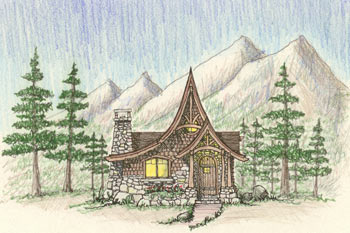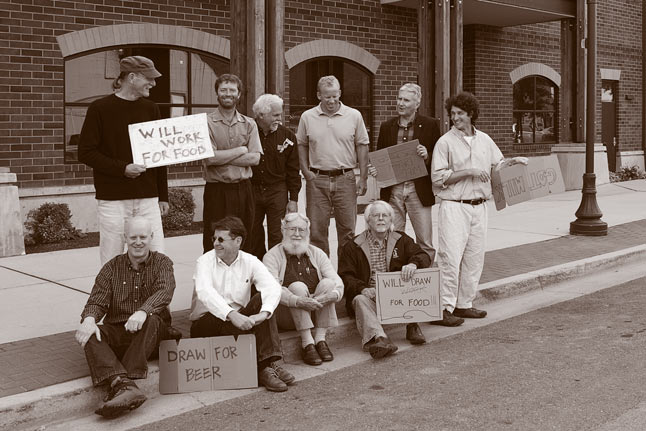|
||||
|
|
|
|
|
|
|||||
 |
To bide his time during work slowdowns, John Hendricks creates storybook cottage-style stock plans like this one with plans to sell them online |
Hendricks plans to sell the unique storybook plans online – that is, when he finds enough time. Ironically, just when things slow down and he gets time to work on his cottage stock plans, an ongoing project comes begging for his attention.
"There's always something to keep us busy," he said.
To view a sample stock plan, visit www.HendricksArch.com and click "On the Boards."
For Jon Sayler, who moved to Sandpoint from Spokane seven years ago, winter is traditionally his busiest time of the year. "After Christmas, we're usually hammered and have our heads to the desk," he said. "Winter's busy, spring's busy – we get a breather in July."
Busy or not, Sayler acknowledges that he has had to adapt to the new economic realities. "This is my 33rd year of practice, and I've never seen anything like this," he said, referring to the slowdown. "This is the biggest one ever – in '07 and '08 we were going like crazy. Then came January of '09 and we thought our phones were cut off. It was like someone turned off the switch."
He keeps his staff of three occupied with projects from clients living outside the area – Walla Walla, Boise, Spokane and other locales – and has also taken on more commercial projects.
Kris Contor of Architecture 311.5, the firm that designed the building that houses Ivano's Ristorante, also keeps up the pace with projects located outside the Sandpoint area.
"We've done a winery down in Walla Walla, projects in Moscow, a house down in California," said Contor, who has been an architect in Sandpoint since 1993. "We've been pretty lucky, staying busy. But I don't see things improving too much in the near future. Homes are so cheap now, it's easier to buy than build."
It's not just Sandpoint that's experienced a steep downturn in construction projects. For the region as a whole – from Lewiston north to the Canadian border – architects in general have seen a big decline in the amount of work that comes their way.
"Competition is fierce, and projects are scarce," said Steve Roth, president of the Northern Section of the American Institute of Architects' Idaho chapter, which includes Bonner County. "Not all of us are doing very well at the moment."
Although Roth is based out of Coeur d'Alene and deals mainly in commercial projects, he said architects from farther outside the northern Idaho area are vying for anything that comes up. "It's not just the local guys anymore," he said. "Everybody's fighting for the same thing."
Over the next few years, Roth believes the climate for architects will improve. "I don't see an improvement in the near future, but I do think things will get better."
To become a licensed architect in Idaho, a traditional five-year education is followed by approximately three years of experience. After that, it's a matter of applying to the NCARB (National Council of Architectural Registration Boards) on a state-by-state basis. At that point, an exam is followed by accreditation if successful.
Sandpoint's Tim Boden, 52, headed off to the University of Idaho to earn his degree and become a licensed architect after working in Sandpoint as a painter and builder in the 1980s. Boden groomed Schweitzer ski trails and split firewood just to make ends meet; he recalls that it was virtually impossible to make a living in the area. Hence, he made his decision to further his education and become an architect.
As owner of Boden Mountain Architecture, he maintains a positive outlook despite the economic downturn. Perhaps because this Schweitzer-area resident can easily turn a slow workday into an awesome ski day, Boden stays hopeful about Greater Sandpoint in general and has noticed that things are ever-so-slowly beginning to improve.
"Sandpoint and Schweitzer are desirable areas to live, with beautiful amenities that other places don't have," he said. These unique qualities continue to draw newcomers to the area, just as they did back in 1980 when Boden moved to Sandpoint.
Because of the area's outstanding scenery and outdoor activities – as well as recent media coverage due to Sandpoint's designation as the country's "Most Beautiful Small Town" by Rand McNally and USA Today in 2011 – Boden has noticed a sense of immediacy among those who are contemplating a new home in the Sandpoint area.
"Some of these baby boomer folks who have lived through the downturn are ready to live their dream and do what it takes. They're not getting any younger," he said.
Boden points out that the recession has brought positive changes to the building industry. "The downturn is making people take a look at their lifestyles," he said. "They're pulling the plug on luxurious, large homes that aren't lived in year-round. They may be building a second home, but they're doing it with a lot less money."
As a result, clients want smaller, higher-quality, more efficient homes. "That's a good combination, because it's going to be a better-built home," he added.
Boden advises clients to build above today's standards for energy efficiency and use materials that are low-maintenance. At his own home at Schweitzer, Boden installed solar panels that heat the home's hot water for eight to 10 months out of the year. "Little things like that are actually kind of exciting," Boden said. "The downturn is helping people make a difference."
Energy efficiency has always been a cornerstone of Bruce Millard's architecture business in Sandpoint – long before it was a trend. He agrees that the downturn has put a positive spin on smarter energy design.
"The great thing is that intelligent stuff doesn't happen when there's lots of money going around; it happens when people start looking at where they can save and start thinking about energy efficiency," Millard said.
His Studio of Sustainable Design specializes in ecologically designed homes, and while his business has slowed considerably from where it was several years ago, he still has projects on the table. The big difference between today's clients and those that he dealt with several years back is that they are building with cash rather than money from bank loans.
"They're looking at the building process in a different manner – they're extremely careful with their money and spending it with future energy costs in mind," he said. In addition, clients are seeking more rural locations to live a more self-sufficient lifestyle.
The notion of living off the land is also what keeps Millard occupied during slower times: "I spend a lot more time in my garden, trying to build greenhouses for myself and thinking about the future." Plus, it gives him time to relax in more exotic locales. Given the fact that times are tough, though, he vacations south of the border where it's "warm and cheap."
Architect Brad Granfield moved to Sandpoint full-time just two years ago, working on primarily residential projects both here and in Florida where he retained his license. "I have the advantage of working in two places while living here," he said.
Being a relatively recent arrival has its disadvantages: "Longtime residents have their hand in the cookie jar more than us newcomers," he said. Granfield fills in the gaps with projects in Florida and working on construction and woodworking projects as a hobby. "It appeals to my creative side," he added.
Granfield agrees with the notion that a movement is afoot for "smarter" homes, adding that clients want to incorporate more eco-friendly features into their homes due to an increased awareness of the "green" industry movement. And architects such as Granfield are the ones helping to promote it. "We're going beyond the tried-and-true methods of construction," he said.
Joseph Wythe, 81, is considered the grandfather of architecture in Sandpoint, and while he is officially retired he still dabbles in design work.
"I still take on projects that are of interest to me," Wythe said. "The economy affects us all. I am working with one couple who needs to sell their homes elsewhere before they can proceed with their project in Sandpoint. And another couple is trying to work with an extremely low budget."
Wythe agrees that energy efficiency is a big factor in a home's design and a long-term investment. He built a log studio for his wife and insulated it so well, they only had to use a 1,500-watt portable heater to keep it warm.
"Building for energy efficiency means higher construction costs, but that's made up very quickly," he said.
Besides smarter ecological design, another positive spin that came about from the recession is when Hendricks and his staff had time to do pro bono (translation: free) work last winter when the firm designed the new band shell roof for the Farmin Park Pavilion.
"From a business point of view it certainly doesn't pay the bills, but it's for a good cause," Hendricks said.
The result of his donated architectural work is a beautiful, sweeping arch design that has already been approved by various committees for construction, and is being funded by Sandpoint Rotary and the Sandpoint Urban Renewal Agency.
As Sandpoint architects continue to stay busy – whether it's enjoying the ski slopes or uncovering artistic talents at the easel, building smaller and smarter homes or helping the community at large – the economic and seasonal downturns have made their marks on the community, and some of it has indeed been for the greater good.
The entire contents of this site are COPYRIGHT © Keokee Co. Publishing, Inc. All rights reserved.
 Some of the town's architects, from left: (top row) Bruce Millard, Sean Fitzpatrick, Brad Granfield, Rob Stoicheff, Jon Sayler and Krister Allen; (bottom row) John Hendricks, Kris Contor, Joseph Wythe and Bill Klein
Some of the town's architects, from left: (top row) Bruce Millard, Sean Fitzpatrick, Brad Granfield, Rob Stoicheff, Jon Sayler and Krister Allen; (bottom row) John Hendricks, Kris Contor, Joseph Wythe and Bill Klein